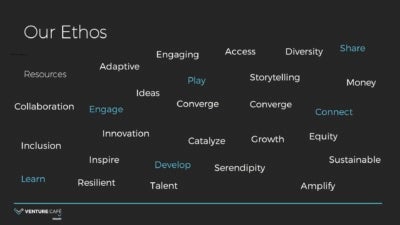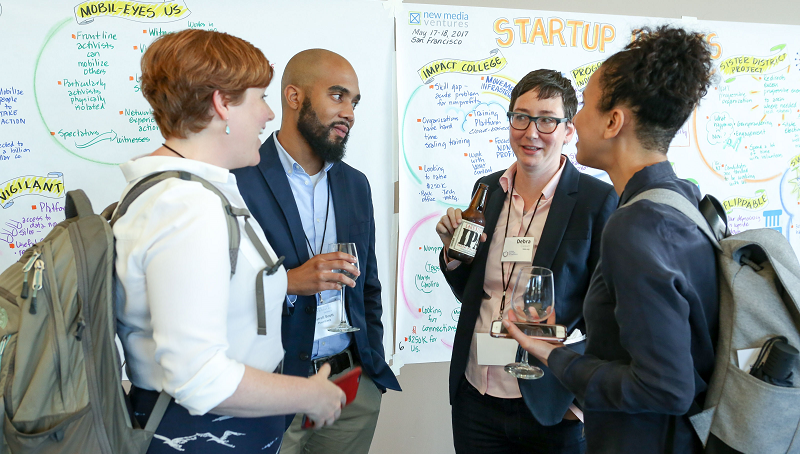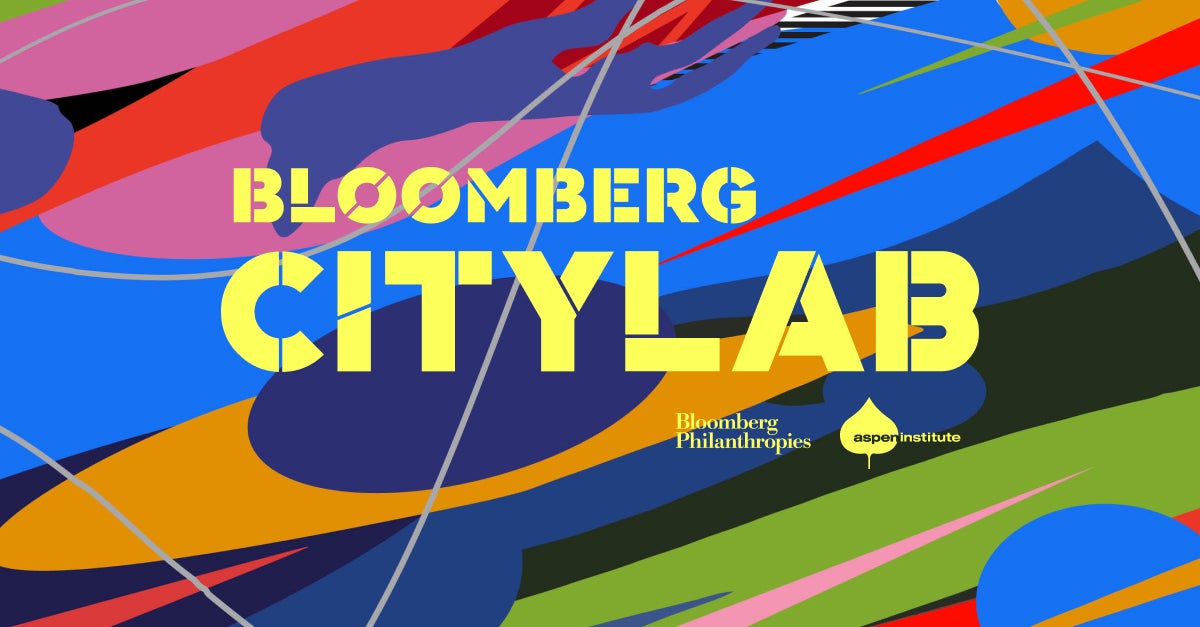Leigh-Ann A. Buchanan is the founding executive director of Venture Café Miami where she facilitates sustainable growth, increased diversity and inclusion, and greater connectivity within Miami’s innovation and startup community.
This interview is the first in The Aspen Institute’s Center for Urban Innovation’s series of conversations with inclusive innovation practitioners.
Jennifer Bradley: What values guide your work?

Leigh-Ann Buchanan, Executive Director, Venture Café Miami
Leigh-Ann Buchanan: There are four main values that guide our work, and we incorporate them into all our efforts towards building an inclusive innovation ecosystem. They are: access, diversity, inclusion, and greater connectivity across lines of difference.
Too often innovation communities have all of the assets, all the right stakeholders, but the greatest challenge to inclusion is that folks are operating in silos—silos that exist along geographic lines, industry lines, any type of differentiating factor you can name or find. Our role is to foster and enhance collaboration through creating pathways, initiatives, or programs that create greater connectivity. Our work is inherently grassroots– not for the community, but with the community. Thus as innovation community builders, collaboration is key, and you can’t collaborate if you’re not connected.
JB: Has there been a time when some of your values were in conflict, and how was that resolved?
LB: We focus on diversity and inclusion, but those are two very separate frameworks, and are, quite often, conflated. It does not necessarily follow that a diverse representation of the broader community in terms of demographic markers somehow equates to inclusion– it’s simply not the case.
Achieving inclusion is hard because it requires that those who hold more power relinquish a little bit more of that power to those who do not hold equal power. That’s not an easy thing to do. It requires an affirmation and action to say, “I acknowledge that I am in a position of power or agency or privilege and I have to relinquish some of that power, agency or privilege to another group who, by virtue of many societal, systemic, all sorts of factors, does not sit in the same position that I do. ” Seldom are people inclined to acknowledge that the positions they hold are a result of holding privilege or by virtue of a favorable power structure.
I think inclusion is often conflated with diversity because it’s a lot easier to measure diversity by quantitative metrics. For example, when reporting on the demographics of our program participants to funders or other advisory stakeholders, I can comfortably state that 39% of attendees are Hispanic, 26% are African American or Black. Well, great. Sounds like we are exceeding most diversity metrics. But, the question is, how many of that 39% or 26% can influence policy, are decision makers, or hold the purse strings to deployable funds? And, most importantly, if not, how are we helping elevate them to such positions?
It’s hard to measure inclusion because I don’t think we have a standard metric of what that means. Subjectively, we can inquire of individuals: “Am I empowered, and do I feel like I can get to x, y, or z goal or objective?” Objectively, we can ask, “Is this an environment where people are both empowered and have access to upward mobility, in terms of financial stature or whatever venture they seek to launch?” That’s a lot harder dynamic to unpack.
JB: What’s the purpose of your values?
LB: Values, in a nutshell, help ground the work that you’re doing. They help serve as an accountability checkpoint to make sure that you’re staying in line with your vision and your mission. Values help define the character of our organization. Organizations and institutions are not people. How, then, do you begin to describe the soul or the spirit of an organization, but for the existence of a clearly, well-defined set of values?
JB: Can you tell me about a time that your organizational values guided you through a difficult decision?
LB: We had an opportunity to launch a hospitality concept space, but we realized that that wasn’t aligned with our values of fostering inclusive innovation, of making accessible, inclusive spaces for entrepreneurial individuals to gather, connect, and learn together, and so we declined to pursue it.
Like most similarly situated organizations, we had to weigh the pros and cons of the venture. Sure, it probably would have secured much-need funding, but ultimately, it didn’t align with our program priorities and operational structure. It did not address accessibility, diversity or inclusion; it didn’t get to the heart of our mission. If we define ourselves as a macro-level engagement platform, then taking on a project that is misaligned with our values and strategic pillars– irrespective of how much of an asset it would be for the community– is not worth pursuing.

Values, Venture Café Miami
I think that a well-defined set of values can be that guidepost, north star, or the compass in helping make sure that your organization is staying on track.
JB: How do you hold yourself accountable to your organizational values?
LB: Our Thursday Gathering events draw between 300-400 people a week, and we have an official staff of two full-time [employees], plus a slew of interns. There’s no way we could do what we do without having 50 or so volunteers that help keep our programs running smoothly. We create open lines of communication and observe a flat, or transparent culture. We engage our volunteers and small team as our accountability partners. If they see that our programming is getting to be more towards happy hour or another event, they’ll check us and say, “This isn’t really what we’re trying to do.” If there’s a night where we have a large concentration of non-people of color, they’ll say, “Hey! What are we doing for outreach?”
There are many different stakeholder groups within our circle that hold us accountable – that would be our Ambassadors, our advisory committee, our board of directors, and then also, the broader community in Miami. Internally, we have a team meeting and every week we’re reciting what our focus and what our aspirations are, but these other groups are our furthest checkpoint for making sure that we stay accountable to what we say we’re going to do.
I’m a big fan of having flat cultures. Yes, you have to have some degree of hierarchy, but transparency is really important in the way that organizations should run and the way we run our organization, which I write about a lot. That transparency also means a degree of relinquishing complete control over what we’re doing. At the end of the day, Venture Café Miami is a macro level community engagement platform, but hyper focused on the innovation ecosystem. And so if our role is essentially community development, the community has to help define and guide the direction of what we’re doing. You have to make sure that the constituents served are part of the equation and making sure we’re being held accountable.
JB: What else should we know about the role of values in your work, or more broadly, in inclusive innovation?
LB: The way in which you communicate your values is very important, and we’ve spent a lot of time designing for this in Venture Café. Communicating your values should be showing and not telling. The more that you can show your values through storytelling, through creating those shared experiences where people can experience it and come to the conclusion that these are your values without you saying it, is a better way of being effective. We’ve learned that. You can say it all you want, but you have to live it, and you have to show it.
We have what I like to call behavioral interventions that are designed so that people can experience the value. If you walk into our Thursday Gathering, we always have people that are greeting you and making you feel welcome. We also have folks that are called floor connectors and their job is to see people who have 1, 2, 3, 4, and 5 on their name tags and go talk to them, even if they’re a different color, even if they are in a suit or not in a suit.
Each value that we have, we try to break that down into, “What are the ways that we can show that and how can we create experiences where people understand that that’s a value without us saying it?” There’s a lot of design and intentionality that goes into living the values. It’s thinking about what are the principles of inclusive innovation, but then, what are the practicalities surrounding these principles? That includes even simple things like making sure public transportation options are always listed on our website and our email, because that’s an accessibility piece. If you haven’t thought through the fact that not everybody has a car, and how can they get there, then you’re not really living true to your values or designing experience as truly accessible.
The other thing that I would say about values is, part of the process of defining your values requires that you incorporate feedback loops, not only at the defining and initial stages, but continuously. Values require that you continuously have this process of iteration of, “Yes, what does access mean?” But access can change at different stages and how you interact with different people. Designing those feedback groups for accountability and feedback in general, I think is really important. It’s a continuous process for evolving how you interpret and deploy your values.
This interview has been condensed and edited for clarity.
This blog series is supported by the Citi Foundation, a vital early supporter of the Center for Urban Innovation at the Aspen Institute. With the Citi Foundation’s help, the Center convened leading-edge practitioners to develop a shared set of principles to guide a cross-sector approach to inclusive innovation in low- and middle-income neighborhoods, and to determine how the Aspen Institute could support this practice.

